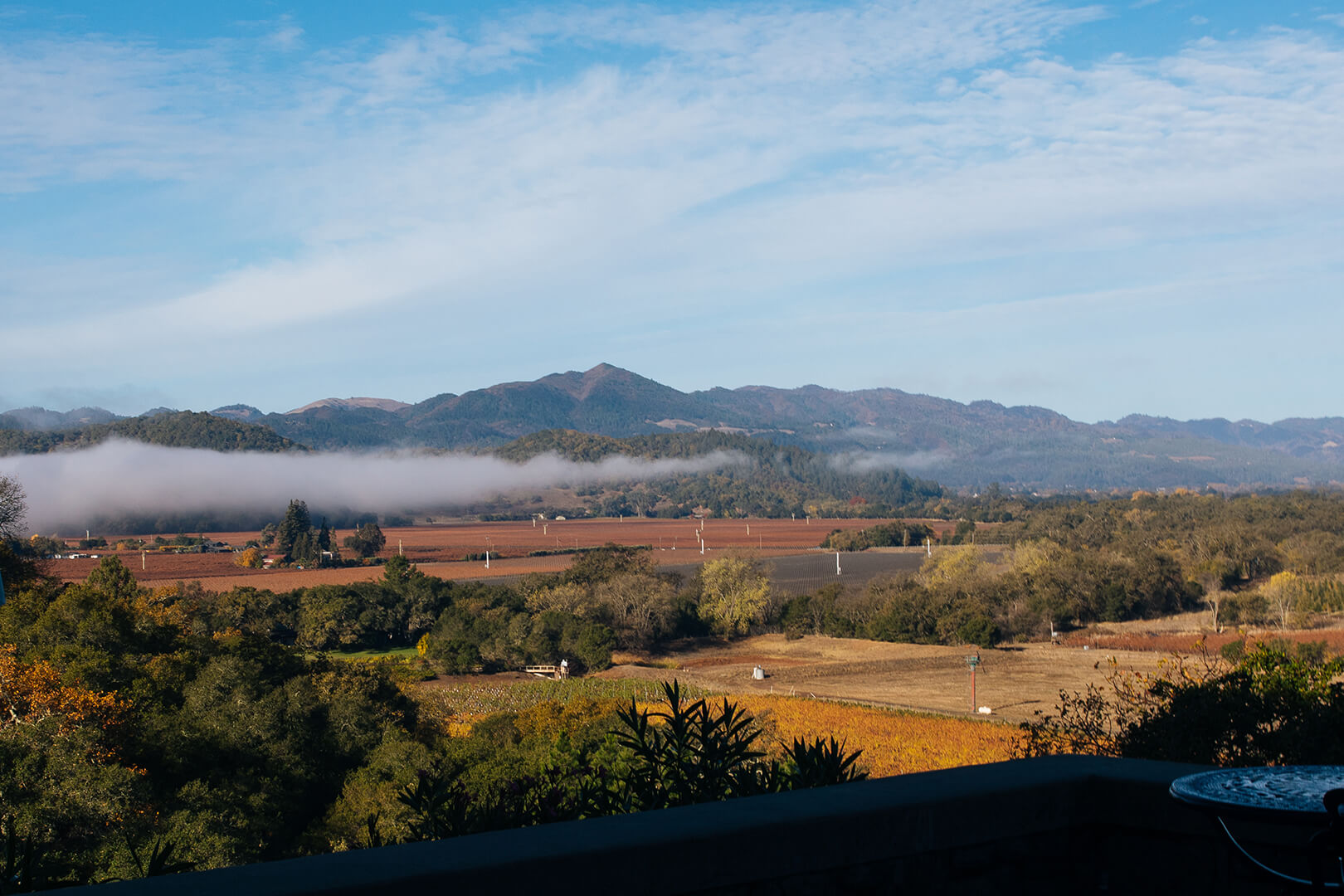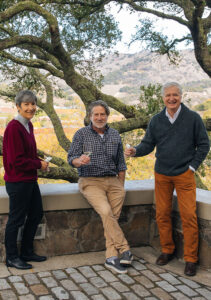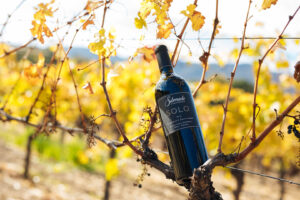[vc_row][vc_column][vc_column_text]
 SILVERADO VINEYARDS BUILDS UPON 4O YEARS OF SUCCESS WITH A NEW CHAPTER AND A NEW LEASE ON VITICULTURE
SILVERADO VINEYARDS BUILDS UPON 4O YEARS OF SUCCESS WITH A NEW CHAPTER AND A NEW LEASE ON VITICULTURE
story by Jonathan Cristaldi / photos by Alexander Rubin

Elena Franceschi, winemaker Jon Emmerich,and president Russ Weis
The year 2020 marked the end of an illustrious chapter for Napa Valley’s Silverado Vineyards. In 2019, the estate’s beloved CEO and founder, Ron Miller, passed away. (His wife and co-founder, Diane Disney Miller, died in 2013.) Meanwhile, the start of the new decade has ushered in the uncertainty of changing consumer tastes, tariffs, and a pandemic to boot. In the vineyard, the availability of labor continued to decrease while the price for it increased; in the market, competition from spirits and the booming RTD category threatened by-the-glass placement for wine on-premise and shelf space off-premise. And even as the winery—along with the rest of the industry—strove to adapt to, pivot through, and navigate the new normal, wildfires wreaked havoc on the California harvest.
Yet amid all the doom and gloom, a bright and exciting new chapter is beginning to unfold at 6121 Silverado Trail. In Silverado’s cellars, 11 new microfermenters were installed so that the winemaking team could continue their focus on single-vineyard expressions. Meanwhile, its sales team kicked off the year with a blitz in the Southeast U.S. market, followed by events in Charleston, North Carolina, and New York, that resulted in record months. And its marketing team completed a new website with built-in tools for the trade, including a digital asset-management system, and launched advertising campaigns to support its impressive portfolio.
In short, as Silverado embarks on a new year—which happens to mark its 40th anniversary—president Russ Weis is optimistic.
“We are so fortunate to own our own estate . . . and [to have] the luxury of looking ahead [through the] generations,” he says. “Ron and Diane’s children are carrying on their legacy as the owners of the winery, and their grandchildren are becoming increasingly involved.” This matters, he adds, because “trusted, storied brands are becoming increasingly important to the trade and to consumers. New wineries will come and go, but you can’t buy history or authenticity. Consistency in ownership, winemaking, and terroir— paired with the size and agility to change direction—is what has made Silverado successful for 40 years.”
The Legacy of the Silverado-Disney Heritage Clone
Key to that success, of course, is the winemaking team. For the past three decades, Silverado Vineyards winemaker Jon Emmerich has turned out wines with a remarkably consistent house style. Regardless of vintage variation, they’re always dark and brooding, built like skyscrapers, and bolstered by the kind of acid backbone you’d expect from a Grand Cru Bordeaux estate. Not that that’s any surprise: After all, Silverado Vineyards sits smack in the heart of the Stags Leap District AVA, arguably Napa’s original “first growth” region. Emmerich avoids overripeness, picking rather to preserve the scintillating natural acidity of the grapes from these world-class estate vineyards as well as to balance his oak regimen between new and used wood.

SILVERADO VINEYARDS STANDS ON SOLID GROUND,
CELEBRATING 40 YEARS IN THE BUSINESS BY PLANTING NEW AND EXCITING VARIETIES ALONG THE PATH IT’S PAVING TO THE NEXT 40 YEARS.
In the cellar, Emmerich is joined by associate winemaker Elena Franceschi, another Silverado veteran who just completed her 26th harvest. Today, Emmerich and Franceschi, along with Weis and the Miller family, are carrying the torch lit by Ron and Diane to prove that their California estate could build a legacy as enduring as that of France’s top châteaux and Italy’s winemaking dynasties. The team currently in place is steering Silverado Vineyards toward such monumental status.
Experts at the University of California, Davis, have also been instrumental in that mission. In the late 1980s, famous viticulturist Phil Freese and Deborah Golino, the director of the Foundation Plant Services department in the College of Agricultural and Environmental Sciences, worked with budwood from Silverado’s estate vineyards to cultivate UCD 30; otherwise known as the Disney-Silverado Heritage selection clone, it’s the only heritage clone from the Stags Leap District AVA and one of only three in California. Their starting point was originally referred to as the See clone in honor of Harry See of See’s Candies fame, who sold the land that would eventually become Silverado Vineyards to Diane, Ron, and Diane’s mother, Lillian Disney; it had been cultivated in an on-site nursery by a former vineyard manager at the estate, John Brock. The virus-treated UCD 30 clone is now cultivated at world-famous UC Davis vineyard Russell Ranch, which “contains just about every grape and clone you can think of,” says Weis.
What’s so special about UCD 30 is that “in a high-pressure drought year, it resists viral attack,” Weis explains. “The problem with drought years is [that] it’s not just an issue of less water in the vineyards—[it’s also] the fact that the immune system of the vine is compromised, and it becomes susceptible to virus attacks. In drought years, UCD 30 maintains its integrity.”

Beyond Cabernet
“It’s not just chocolate and vanilla anymore,” jokes Weis as he reflects on Silverado’s heritage as a house of Cabernet and its future as a house of many varieties. Just before Ron Miller died, he was enthusiastic about the replant of Miller Ranch, the winery’s 81-acre estate in the Yountville AVA. Weis remembers asking Ron which grape he would plant if he could plant absolutely anything in the world, and “[he] mentioned that he loved Pinot Blanc from the early ’70s from Napa. I said, ‘We could do that!’” When Silverado called Golino at UC Davis to ask about Pinot Blanc, however, she set the record straight. “She said, ‘He doesn’t actually want Pinot Blanc,’” Weis recalls. “‘He wants Melon de Bourgogne,’ which is what it was.” So instead, Silverado secured some Melon de Bourgogne from Russell Ranch. After grafting at a nursery, it will soon make its way to Miller Ranch.
“It’s fun for Jon and Elena and me,” says Weis, who adds that “we just finished a series of tastings of the Loire, Collio, and wines from Alto Adige, which the Millers really liked. We are looking at grapes like Sauvignon Vert as well as Chenin Blanc, and we’re excited about opening the door a little wider.” Seizing such opportunities to venture into new territory “is a function of the next generation of Millers. This is what they are interested in. It’s great for [them] and it’s great for us, energizing us in our fifth decade.”
Pivoting On- and Off-Premise
The recent innovation in Silverado’s vineyards is being matched by resolve at the distribution level that’s worth taking note of in the pandemic era. As the market increasingly moves online, producers working with third-party platforms are often required to offer discounts to entice customers. But not Silverado. “We’re not responding to the retail environment by dropping prices,” says Weis, who asserts that doing so would negatively impact the brand’s extremely strong presence. Given recent stats, he appears to be right: As of June 2020, Nielsen ranked the winery number one for estate produced, luxury-tier domestic Cabernet Sauvignon nationwide “and number seven overall for dollar ranking,” with same-store growth rising a whopping 7%.
Silverado has historically relied heavily on on-premise sales, so to support restaurants that support it, the winery will start offering six-packs of its Cabernet as of the 2018 vintage, thereby mitigating the greater risk and expense buyers face with cases. “We had already [been] doing that with our Chardonnay and Merlot, but we hadn’t done Cabernet, and so it was a continuation for us,” says Weis. “It eliminates breakage charges from wholesalers. All those fees add up—breakages, delivery, et cetera.”
Weis also points out that wholesalers are “absorbing a lot of the on-premise fallout,” and he doesn’t shy away from straight talk about needing those wholesalers after the pandemic more than ever. “We’re all going to be a little bruised, but we’re not going to want to come back just the way it was before,” he says. “We’re doing our part now to help mitigate that—for wholesalers but also for retail and restaurants.”
Despite the uncertainty in the market today, one thing is sure: Silverado Vineyards stands on solid ground, celebrating 40 years in the business by planting new and exciting varieties along the path it’s paving to the next 40 years.[/vc_column_text][vc_separator color=”black”][vc_row_inner][vc_column_inner width=”2/3″][vc_column_text]
Tasting Note
Silverado Vineyards 2017 GEO Cabernet Sauvignon, Coombsville, Napa Valley ($75)
Black, inky earthiness defines the nose and palate, along with a round, silky mouthfeel. Cocoa and dried violets appear against a slightly dusty backdrop, while notes of leather, black olive, and slate are soul-stirring. This vintage is GEO’s most elegant to date, but its robust, statuesque character remains intact. 96 —Meridith May[/vc_column_text][/vc_column_inner][vc_column_inner width=”1/3″][vc_single_image image=”15129″ img_size=”500×500″][/vc_column_inner][/vc_row_inner][/vc_column][/vc_row]
